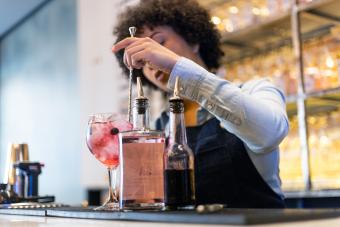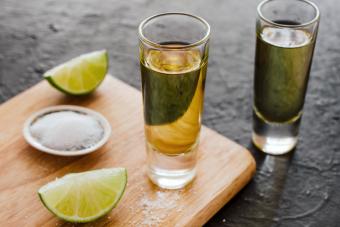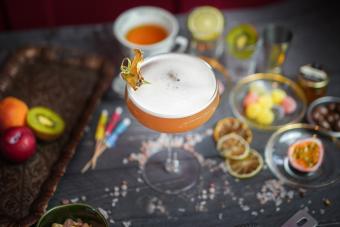
So you want to know what your bartenders are chattering about, or you want to ace your interview to become a bartender? Perhaps you're just looking to step up your bartending game and grow your knowledge. Bartender terminology isn't as tricky as you think. Grab some notecards and get studying these must-know bartending words and phrases! Maybe don't make a drinking game out of it, though.
Bartending Terms While Working
Outside of phrases about cocktails, there's some common jargon you'll hear a bartender or server use.

- 86ed: Bar slang for running out of item or discontinuing something.
- Behind the stick, behind the pine: Simply put, working behind the bar.
- Burn the ice, burn the well: The ice needs to go! It could be because someone broke a glass or spilled something into the ice well (in which case you'll see someone spray a red 'x' across the ice with grenadine) or it's the end of the night, and the ice is melted with hot water.
- Clopening: To close the bar and then be the one to open it the next day. This is particularly tough if the bar closes at 2 and opens up at 11.
- Comp: To buy or give the guest a free drink. Essentially, to remove an item from a guest's bill.
- Guest bartender: A bartender that's working at a different bar than their home bar as a favor or part of a fundraiser or series.
- Mise en place: To prepare everything ahead of time by making sure bottles are stocked, garnishes are ready to go, and everything is in the proper place for service.
- On the fly: Quickly, immediately, as soon as possible.
- Service: A shift, such as dinner service or lunch service.
- Staff meal: The meal some restaurants provide for their staff for free prior to service, as they will be working during the typical meal hours and often don't get to eat until late in the night.
- Turn: When a guest's experience has ended, and a new customer takes their place. This can include several turns over the course of the night at a restaurant, as the business ebbs and flows in how busy they are.
Working With Others
Bars are small spaces. Make sure you avoid running into your coworkers and know where you need to find necessary supplies or where you'll be working.
- Behind: Working behind a bar is a pretty narrow space, with plenty of room for flying elbows and collisions. Saying behind lets others know where you are to avoid those mishaps. No one wants broken glass or a spilled drink.
- Corner: Just like behind, if you're carrying something sharp, tricky, or hot, you don't want to collide with someone you can't see as you're going around a corner without knowing what's there. Announcing "corner" prevents accidents.
- Marry: To merge two of the same ingredients together. If there are two open bottles of vodka of the same brand, they may marry them together into one to save space and put another full bottle onto the shelf instead of hunting down a bottle during service. In some states, this practice is against the law.
- Service area: The area where the bartender exits and enters the bar and often where the servers pick up drinks for their guests. Don't stand here, or you'll slow down the flow of the bar. And no one wants to wait longer for their drink.
- Service bartender, service well: A bartender that works the service well is making drinks for the rest of the bar and restaurant, specifically those who aren't sitting at the bar. Here you'll usually find everything the bar needs to make most classic cocktails and any cocktail ingredients on their house menu.
- Speed rail, speed rack: A place for the most common liquor and liqueurs a bar uses to optimize the output of drinks without the bartender having to run to different ends of the bar for ingredients. There are usually a couple of different speed rails. These are also often where you'll find house or well ingredients.
Terminology to Know When Making a Drink
There's more to ordering a drink than specifying your garnish or how you'd like a martini prepared.

- Back: Not just a body part. A back is typically a mixer such as cola, water, or another nonalcoholic beverage, usually over ice served alongside an alcoholic drink, which is usually served neat. Example: whiskey with a Coke back.
- Build: Another way to say you're making a drink. Often used when describing how to make a longer-form drink, such as a mai tai or a mojito, but not with two or three ingredient drinks.
- Chaser: Similar to a back, but a chaser helps to cleanse the palate (usually after a shot), although you'll sometimes see individuals chase sips of neat liquor with their back.
- Dry shake: To shake a drink without ice.
- Flame: To literally take a flame to a garnish, specifically a citrus peel, causing the oils to spark and embellish the flavors and aroma. Usually done with a match.
- Float: To slowly add a final layer to a drink, floating it on top of the other ingredients.
- Frost: To rapidly chill a glass to make the outside of it frosty like a window pane in winter.
- House: The bar! For example, a house gin is the bar's pick for well gin. These are typically lower-cost liquors.
- Mixers: Nonalcoholic ingredients, such as juice and soda.
- Muddle: To crush or mash ingredients together with a muddler.
- Rinse: To briefly and lightly introduce an ingredient to a cocktail by swirling it around the glass before dumping it out.
- Shooter: Another name for a shot of liquor.
- Smoke: To introduce smoke to a drink by lightly torching wood chips or a wooden plank. The smoke is captured in a cloche or in the cocktail glass, either before or after the cocktail is built.
Cocktail Specifications
Building, stirring, shaking, and measuring a cocktail - there are several ways to say the same thing.
- Call, Call drink: Otherwise known as a top-shelf drink, as you're "calling out" or naming your preferred brand of liquor in your cocktail.
- Dirty: Dirty is when you add olive brine to a drink, such as a martini.
- Double: A double has double meaning. It could mean a double shift, such as working lunch and dinner in the same day, or it can mean double the alcohol serving in a drink.
- Dry: There are varying degrees of dry. A dry martini means using dry vermouth, an extra dry martini is with a dry vermouth rinse, then discarding the remaining from the glass, and bone dry means absolutely no dry vermouth at all. Don't even glance at the vermouth bottle while stirring. If you order an extra-dry martini, specify that you want very little vermouth, as some bartenders make take extra dry as meaning you want additional vermouth.
- Finger: An old and inconsistent way of measuring a drink. Two fingers of whiskey yields more whiskey than one, but how much whiskey you get depends on the size of your bartender's hands. Stick with ordering a single or a double.
- Free pour: To pour without using a jigger or another method of measuring ingredients. You can sometimes see or hear a bartender counting to measure their pour, often a four-count for a single.
- Jigger: A bar tool used to measure ounces, typically with 2 and 1 ounce measurements on a double cocktail jigger.
- Neat: Served down in a rocks glass, without ice.
- On the rocks: Served over ice.
- Pony: A one-ounce shot; however, this is an antiquated term that you don't hear much anymore.
- Premium: Top shelf liquor, or liquor that isn't bottom shelf or well.
- Single: A 1½ ounce pour of liquor. This can also vary by establishment. Some consider a single to be 1¼, while others err towards two ounces. A double is two singles in a single glass or cocktail.
- Splash: Just a touch or smidge of an ingredient.
- Top shelf: The top or best liquor at the bar.
- Well or rail, well drinks: Also known as house, these are the liquors you'll find in the speed rail. These are usually lower-cost liquors.
- Wet: Adding more or extra mixer to a drink than the recipe usually calls for.
The Bartender's Club
A few final terms to know, or unlearn, as you step behind the pine.
- Bartender's handshake: An unofficial acknowledgment that the bartender finds you cool. This can be as simple as the bartender buying you a shot at another bar, at their own bar, or typically treating you like something more than just a usual regular. Congratulations! This is like making platinum status at an airline. Don't change what you're doing.
- Bruised: This isn't real, you can't actually bruise alcohol. Have your martini shaken, it'll still be a martini.
- Last call: This is when the bar can legally make you your last drink. This varies by bar and by state based on liquor laws. Don't try to order a drink after last call. Last call is law and can jeopardize the safety of the bar as well as their liquor license.
- Nightcap: The final drink.
- Up, straight up: Up means to have the drink served in a stemmed glass, chilled. Straight up isn't actually a technical bartending term. Some use it to mean neat, and others use it in place of up. Stick to the usual up or neat when you order.
Exploring Other Bartending Words & Phrases
Dip your toes into the world of bartending by studying up on garnishes, when to use cocktail shakers or mixing glasses, how to properly build a drink, and how to prepare a drink the right way. And of course, which glass to serve the drink in! Be sure to know whether you're using king, crushed, cracked, or regular ice.

Sounding Like a Bartender
With even just a handful of these terms under your belt, you'll have a better grasp on what's happening around you at the bar or work your way from the floor to behind the bar with a little extra knowledge. Whatever the reason for wanting to expand your bartender terminology, you're on your way to sounding like a pro.







